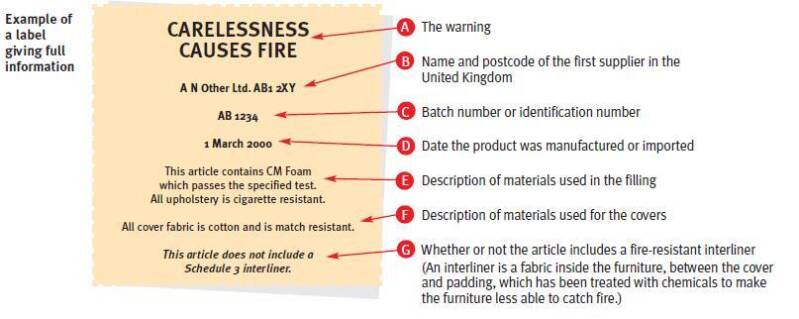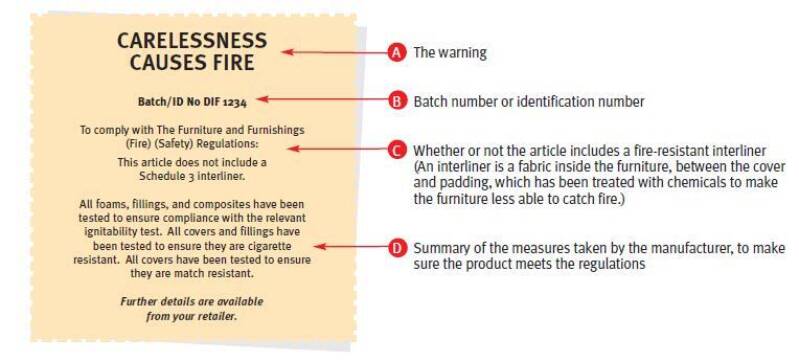What is ‘upholstered furniture’?
Upholstered furniture includes, but is not limited to, the following items:
- Sofas
- Beds and mattresses
- Cushions
- Loose covers and stretch covers
- Nursery furniture – cots, high chairs and so on
- Garden furniture with soft covering if it is suitable for use indoors
- Furniture in caravans
The following items are not covered:
- Sleeping bags
- Duvets and bedding
- Curtains
- Furniture made before 1950
Upholstered furniture that has been reupholstered or refilled since 1988 must meet fully the current legal requirements regardless of when the furniture was originally made. It is an offence to supply such furniture without a permanent label. Examples of permanent labels are as follows.
Example of a label giving full information:

Example of a shorter label:

What types of furniture do the requirements apply to?
New and second-hand upholstered furniture supplied by a business must meet certain fire-safety requirements.
What are the fire-safety requirements?
- All furniture must pass the cigarette test.
- Filling materials must be fire resistant.
- Covers must pass the match test.
The Department of Trade and Industry has produced detailed guidance notes about furniture safety regulations with examples of the labels you should look for. If you would like to see this information, go to www.gov.uk or contact us.
A copy of the Furniture and Furnishings (Fire) (Safety) Regulations 1988 is also available for you to download from the Office of Public Sector Information website. If you would like to see this, go to www.opsi.gov.uk You can also buy a copy from The Stationery Office (TSO), Arthur Street, Belfast.
How can I tell if furniture meets the conditions?
All furniture that meets the conditions must be labelled with display labels and permanent labels. There are three types of display label to use depending on the circumstances. If you are selling upholstered furniture direct to the public, it is your responsibility to make sure the furniture is labelled with the correct display labels. The permanent label is headed ‘Carelessness causes fire’ (mattresses have a label stating that the mattress meets BS 7177). If a piece of furniture has a permanent label in red letters, it does not meet the requirements, as these labels were used before the current laws came into force.
If you give a piece of furniture away, this is still classed as supply and you must make sure it meets the requirements above.
Examples of display labels:

How can I tell if second-hand furniture meets the requirements?
All furniture that meets the conditions must be labelled when it is new. It must have a permanent label headed ‘Carelessness causes fire’ (mattresses have a label stating that the mattress meets BS 7177). If a piece of furniture has a permanent label in red letters, it does not meet the requirements, as these labels were used before the current laws came into force.
You should get expert advice before selling any second-hand furniture that does not have the correct permanent label.
You can get useful information and advice from the following:
The British Furniture Manufacturers
30 Harcourt Street
London
W1H 4AA
Phone: 020 7724 0851
The Association of Master Upholsterers and Soft Furnishings
102A Commercial Street
Newport
South Wales
NP20 1LU
Phone: 016 3321 5454
Website: www.upholsterers.co.uk
The Furniture Industry Research
Association FIRA International
Maxwell Road
Stevenage
Hertfordshire
SG1 2EW
England
Phone: 014 3877 7700
Website: www.fira.co.uk
Does furniture containing glass have to meet any special requirements?
There are no requirements specifically for glass in furniture. However, the law says that all goods must be safe, so it is your responsibility to make sure all the furniture you supply is safe. The best way to do this is to make sure the furniture meets the relevant standard BS 7449:1991 which covers glass in furniture or BS 7376:2004 which covers glass in tables and trolleys.
If you make furniture containing glass you should get a copy of the standard from:
BSI
389 Chiswick High Road
London
W4 4AL
Phone: 020 8996 7720
You should have your products tested against the standard.
What are the requirements of the standard?
The requirements include:
• how exposed edges must be smoothed or sloped;
• the size and strength of supports for shelves and table tops;
• the strength, security and stability of glass; and
• the labelling and warnings that are necessary.
How do I know if the furniture I have in stock is safe?
First, you should check all the items in stock for possible dangers and see if they are labelled with the standard numbers BS 7449 or BS 7376. If you are still not sure, contact your supplier. Always use suppliers with a good reputation when you order new goods.
Tell the supplier (preferably in writing) that goods must meet the standards and keep copies of invoices or other documents.
What should I do if I think the goods are dangerous?
You should immediately stop selling them and have them repaired or changed to meet the safety requirements or contact your supplier to ask them to make the changes.
You must not sell dangerous goods. If you do, you could be fined or given a prison sentence.
Contact Us
If you would like further information, please contact us at Ballymoney Office, Riada House, 14 Charles Street, Ballymoney BT53 6DZ or Limavady Office, 7 Connell Street, Limavady, BT49 0HA